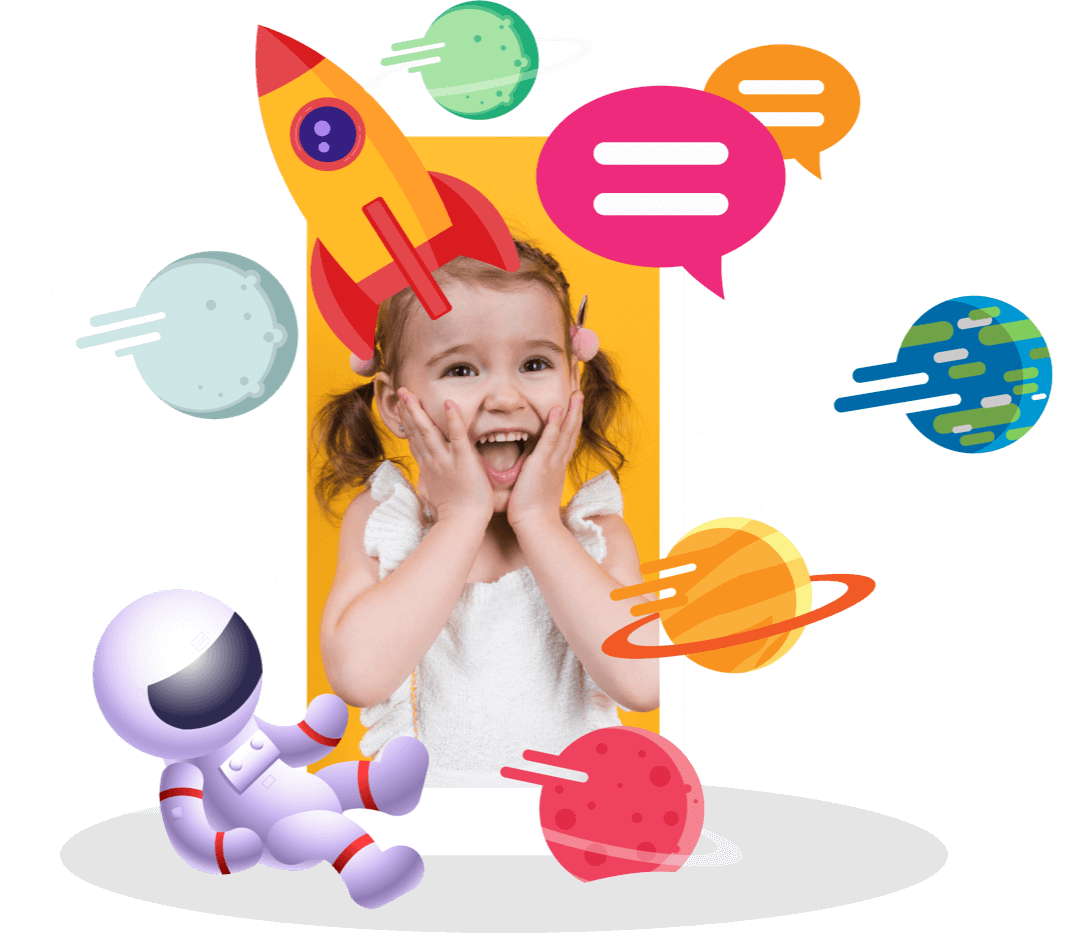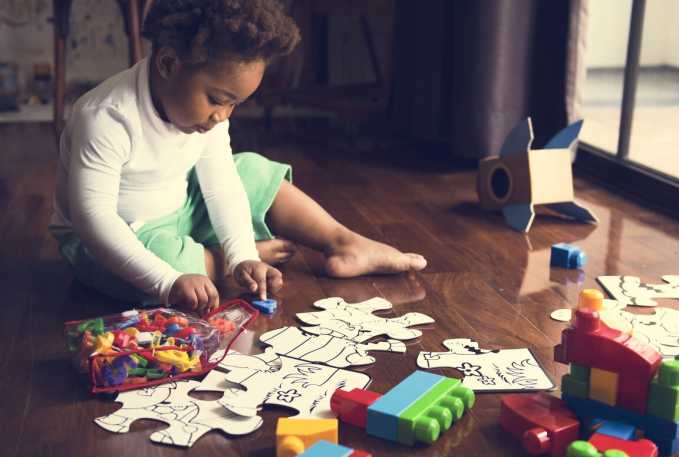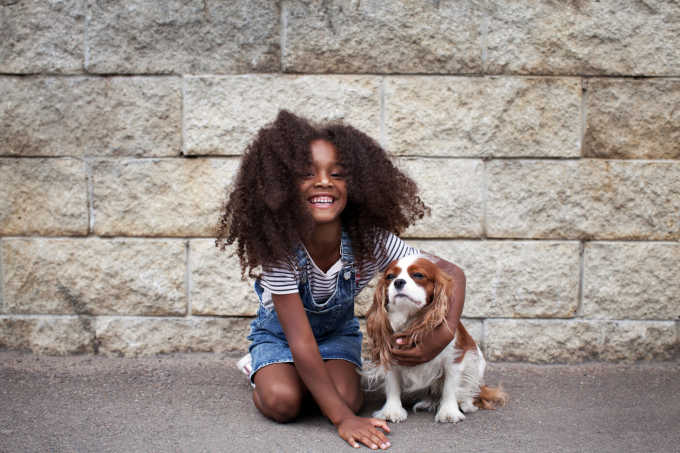Summer is over and it is time to go back to school. Seasons change, and along with it comes different schedules and routines the child has to get used to all over again. With the pandemic upending our lives (and the structures that have been working well previously), it may be particularly difficult to adjust to the school season this year. But fret not, because here we have prepared a guide to get you started on the new (and kind of a different) back-to-school season.
Back to School Activities for Preschoolers
Getting children up to speed and having them be comfortable in the school setting can take a lot of effort, especially after a long time we spent at home. Here are some preschooler activities that teachers and parents and caregivers can try out to make the transition a little bit easier.
Color matching box
Pick up a leftover cardboard box and put holes on the cover. The number of holes will depend on the number of color pencils or crayons, or markers you have at hand. Paint around each hole with a color you have and ask the child to put the color markers in the corresponding and correct color spot. This will increase their hand-eye coordination as well as their fine and gross motor skills. The child’s numeracy skills will also be boosted if you count how many holes are left to be completed.
A get-to-know-me train
This is an excellent activity for more than one child as this activity will help children get to know each other. You can make or print out a locomotive, on which you will print out and stick a child’s photo. Leave empty spaces on the train’s wagons to put facts and things about the child, like their names, favorite food, and favorite colors. Make this for each child. You can increase the number of wagons as much as you like. At the end of this activity, you can list the items on the wagons to introduce the child.
Counting sticks
This is a simple yet really effective way to teach children about numbers. Get some popsicle sticks and write numbers through 1 to 9. Separately, prepare some clothespins on which you will put plastic or paper numbers on the clipping part again through 1 to 9. Then ask the child to match and set the number on the clothespin to the popsicle stick.

Back to School Tips
This fall, children may need a little more backup to prepare for getting back to school after an unusually complicated pandemic year. Here are some general back-to-school ideas and safety tips that will make your child’s transition from the summer to the school routine as smoothly as possible.
It’s okay to be overwhelmed
Back-to-school transition is already a big task to accomplish, let alone a complicated one following a year full of turmoil. So before beginning preparations, know that it is quite alright to feel anxious and overwhelmed. The same goes for your child. You should let your child know that this is normal and encourage them to ask for help whenever they need it. Sometimes it may be challenging to navigate through the school, or the child may need assistance with a subject. Let them know that it’s encouraged to ask questions and help. Since the COVID-19 pandemic has been a tough year, the children need to know that they are in a safe place at school.
Encourage safe hygiene practices
COVID-19 is not a joke. Although vaccines have gotten many of us through the thick of it, being safe and taking precautions is still important. This may especially be difficult to manage with small kids. To start, telling your child about the importance of washing hands to stop the germs and using masks would be a great start. The Centers for Disease Control and Prevention guide for COVID-19 prevention for K-12 schools is a great source to inform and give tips about safety against the virus.
Set realistic and small goals and expectations
Explain to your child that this year might look different from other times they went to school. They may be required to wear a mask or practice social distancing, depending on their school district. Talk to them about their expectations to ease the process.
It may also be difficult to adjust to a new routine where the child doesn’t have to roll out of bed and get into the class right away. This may create some problems with their focus, in turn affecting their classes in general. So tell them it may be challenging at first, but they will get used to this new normal, and all will be well.
Mental health is essential to protect and prioritize
The pandemic has undoubtedly created a lot of stress and trauma for the children and their families. Parents and caregivers should make sure that their children speak up about how they are feeling. The school counselors will be there to help your child. Another thing to do during this time is to give your child the space to feel proud of their accomplishments. Don’t just focus on the improvement areas and learning loss over the past year, and celebrate how they managed to get through a tough time and they can and will do better.
Come along with 200k+ families!
Explore the endless possibilities of learning!
Download for Free.
Back to School Ideas For Parents
Children are not the only ones affected by the back-to-school season. There are a lot of things to get the children ready for school, and COVID-19 only increased the number of things to do. Here are some ideas to go over and things to do to get involved with your child’s school season.
Deal with the stress of it together
Stress and challenges may be hard on your child, especially after spending so much time at home during COVID-19 and returning to school in a different atmosphere. Calmly dealing with this stress through useful tools will prove helpful for your child’s education and help them become more resilient for future stress factors and challenges. Stress may look different on every child, so make sure to keep an eye out for changes in their behaviors, such as poor performance at school or unhealthy sleeping or eating habits. Make sure that you talk with your child about what is going on around the world, answer any questions they may have, and be their role model in implementing healthy habits like regular sleep and exercise.
Encourage being active
Physical education is such an important element to being a healthy student. Children spend about 6 to 8 hours a day at school. This is a good chunk of time to spend on your child’s development of motor skills, behaviors, socializing, and knowledge. Studies have shown that 60 minutes of physical activity every day is crucial for increased focus, improved bone health, better heart health, lower risk of depression, and better grades.
Create quality family time
We had the chance to spend much more time with our family together this past year. This sudden change in family time may stress out your child and create separation anxiety. To overcome that, make sure that your child knows that you support them and create and schedule quality family time, where you can have dinner and talk about how their school went. This will allow the child to know that there is a space to express their feelings and thoughts, and they will have something familiar to look forward to after school.

To-do lists are our friend
School mornings are stressful. Creating to-do lists would make it a bit stress-free. Just plan ahead and write down what you will need to do the night before. This could be preparing lunch for your kid, selecting an outfit for them, or even small things like setting the alarm clock. Listing out everything will reduce your stress.
Back to School Themes
Back-to-school themes full of fun activities will help the child be engaged in the educational material and help you understand where your child is at in terms of learning. They will help you see if your child has learned colors or shapes. Here are some back-to-school themes you can try out with your child.
Match the alphabet
You can find samples online or easily create one yourself. Get a blank sheet of paper and put the alphabet on it. You can focus on either the uppercase or lowercase letters or maybe increase the difficulty a bit and use both. Then, get your hands on some colorful letters that you can find at the craft store. Then, ask the child to match the letters with the letters on the paper. To make it more fun, you can use some small, round hook and loop fasteners or velcros and attach them to both the sheet and the letters and have the child stick them on the paper.
Sort them out
This theme will help your child differentiate the heights of the objects. You can prepare a plastic sheet where you can indicate where the tallest and the shortest object will go with arrows. Then print out pictures of some objects, like a ruler or a scissor or an apple. Ask the child to sort them from shortest to tallest or vice versa. You can also do this practice for sizes. Print out pictures of apples, all varying in size. Then have the child sort them from the biggest to smallest.
Name tags but better
This is another great activity where children can practice the letters and sounds in their names. For this one, select an item like a school bus or a crayon and print a picture out of that. Divide and cut the picture into equal squares. The number of squares should match the child’s name. Put the letters of the child’s name into these squares. Also, cut out the top and bottom sections of the crayon. Then ask the child to use the glue to line the letters in the correct way to spell their name and stick it on the paper with the top and bottom parts of the crayon. Allow them to use their favorite color and show their handiwork to their classmates after.
Back to School Essentials
There are some must-have items before your child goes back to school. Considering that your child may also attend classes remotely depending on their school district, the list can change. However, here is a brief list of essentials to help your child be organized and focused during the school day and beyond for back to school season:
- Backpack
- Lunch box
- School lockers if applicable
- Stationary
- Pens and pencils
- Erasers
- Pencil case
- Ruler
- Coloring pencils
- Notebook
- Water bottle
- Hand sanitizer
- Masks
This is not an exhaustive list, but back-to-school times can become chaotic, and this would give you an idea of what the essentials are, and you can go from there for an exhaustive list.

Back to School Checklist for Parents
Even though we go through it every year, back-to-school season can still baffle parents. We know it can be challenging, so to make things a little bit easier, here is a back-to-school checklist for parents that is full of useful tips and information.
Set up a schedule
Getting organized before the school year will make things a lot easier. But setting up a schedule for the first couple of weeks of the semester is also essential to get your child into a solid routine. This schedule will include not only your child’s study and school time, but also bedtime and homework time. For instance, you can set the homework time right after your child gets back from school with fresh information in their mind. Also, if your child has special educational needs, their additional preparation or special education assignments should be included in the schedule. This could be the practices for speech therapy or exercises for motor skills, for instance.
Meal plans are helpful
To avoid thinking about what to prepare for lunch for your child and getting stressed about it every single morning, you can draw up a meal plan. What you need to consider is if your child has any food preferences, allergies, or something they need to take with them that day. Preparing a plan for that will make things a lot easier. You don’t have to make them a six-course lunch. Just make sure that you include all of the essentials, like fruits and vegetables as well as protein.
Get your school supplies and spares
School supplies are an essential part (and sometimes the fun part for the adults) of school shopping. Your child’s school may provide them with the basic stationery they need to use in class, but it is still good to stock some spares. It is possible that your child may lose a pencil or an eraser here and there. Their stationery may include pens and pencils, erasers, notebooks, glue sticks, pencil sharpeners, rulers, binders, a pencil case, book covers, name tags, colored pencils, crayons, and so on.
Plan to be involved
A parent’s or a caregiver’s involvement in a child’s education is essential in so many aspects. You will give your child the best shot in their academic life by supporting them along the way. So make sure to plan to be involved in this process. If they have any school events, add them to your family calendar so that you can attend. It is also important that you attend school meetings where you will get to know your child’s progress or needs. If your child has an IEP, make arrangements to meet with the teacher to review the strategies and see if you have any questions in mind, don’t forget to ask them. You can also provide a list of your child’s improvement areas as well as strengths so that the teachers can accommodate the child’s needs in the best way possible. Also, arrange doctor’s appointments and checkups to make sure everything is on track.
Back to School Games
You might be looking for activities to get your kids excited for the school year. We have gathered four fun things and activities to do that will improve their sense of teamwork and help them socialize. These fun games will be the perfect way to entertain your child while also educating them at the same time.
Snatch the letter
This exercise is great for toddlers and preschoolers and it teaches them letters. For this, you can set up two buckets and use foam letters. Fill one of the buckets with foam letters and leave the other one empty. Put these two buckets at least twenty feet apart. Then, ask your child to find a letter and run to the empty bucket and put it in. This will be a great physical exercise, too! If you would like to make it a bit more challenging, ask the child to sound out the letter!
Toys in a basket
This is a pretty simple game to play but so much fun! Draw or print pictures of baskets on separate sheets. Put a number on each of them. Then, ask the child to read out the number on the paper and then count the toys to put in the baskets.
Puzzle race
If you are playing with multiple kids or a group of kids, this is a great exercise. Try and get your hands on a couple of the same simple puzzles. This could be of a world map so, at the end of the practice, the children will be able to see the map as well! Group the kids and tell them to work together and encourage them to be the group to finish the puzzle first!
Back to school vocabulary
Prepare sheets with the alphabet on them. You can pair up the children. Depending on their ages, you can set the timer to 10 to 15 minutes or, if they are older, to 3 to 5 minutes. The aim of the game is to write down as many words as they can come up with, starting with the letters on the sheets. The words have to be related to school! They can write down more than one word for each letter, but they will select one word to read once everyone is done. If no other player used that word for the chosen letter, then that team gets the point!
Come along with 200k+ families!
Let's communicate better!
Download for Free.
How to Get Ready for Back to School
Some love it, and some dread it. Nevertheless, back-to-school season is here yet again. Before the school season starts, there are boxes to be ticked off in your to-do list, and being organized will make things much easier when the day comes. Here are some tips to get ready for sending your kid back to school.
Start setting a bedtime routine:
Try to get your kids off to bed earlier now that the school season is starting. Whether your child will be remote learning or go to the actual school, starting the mornings right is key to a successful school day.
Set a morning routine:
Waking your child up at a set time slowly before school starts will enable them to get used to the routine of it and get into a normal sleep schedule after the summer break.
Talk to your kid:
What’s their goal? Do they have any concerns about going back to school during a pandemic? Talking to your child about their academic goals and achievements they would like to get as well as the feelings they are having, will make them feel included in the process. You can adjust their expectations based on the current situation, give them useful safety information, and make them feel like they are supported, which will in turn yield a successful transition from summer break to school season.
Be on top of the schedule:
Preview the school schedule and calendar beforehand. Take note of important dates like parent-teacher conferences or events your child will attend. Getting caught off guard by a surprise event will be stressful and previewing the schedule and talking to your child’s teachers about it will make it less so.
Get doctor’s appointments out of the way:
Have your child get checked up and go to their regular appointments to make sure everything is on track. If your child needs special education or speech therapy, schedule appointments to be on top of your child’s progress and to determine the next steps, as well as to adjust your child’s education plan if need be.
Stock up on supplies:
Stock up on the essential items your child will need at school, like pens and pencils. You can also turn this into a family event. Take your child to the stores and stock up on what they need and make it fun!
Going Back to School During COVID-19
This year is a bit different than other back-to-school years we have had in the past. Now that we have a lot more information about the virus and its effects, there are more ways that we can do to protect ourselves, and this goes for the children as well.
What school and learning will look like depends on the local decisions made by school boards and government officials. Generally, there are three options: distance learning, where all instruction is done remotely, in-person schooling, which is similar to traditional schooling with safety precautions and procedures, and hybrid education where both distance and in-person schooling elements are used.
The Centers for Disease Control and Prevention stated that schools have not been a major cause of Covid spreading events. The reason for that is there has been a number of measures in place to prevent this from happening. Wearing masks indoors, keeping a social distance, and encouraging hand washing and other hygiene practices made a huge difference.
The Centers for Disease Control and Prevention did a study of schools in Missouri conducting full in-person instruction where masks were mandatory and social distancing was practiced. Here, the results showed that secondary transmission among students was rare. Similarly, in Utah and North Carolina , school transmission was found to be low even during a surge of cases.
Of course, anything can change. In-person school can be interrupted depending on the current situation. The new variant of the virus has caused a surge in cases, but many of the teachers and staff and people in general are now vaccinated, which is thought to help reduce transmission rates in school. Overall, studies show reassuring results in terms of children being at school and the risk of complications of the virus.
Another aspect of not going back to school is some of the setbacks this causes. Results of a number of studies showed that among young people and children, the risk of educational as well as mental setbacks related to children being at home seems higher than the risk of complications from COVID-19.

Is it Safe to Send Kids Back to School?
Schools are not just places where children learn. They are also places where students gain social and emotional skills and get exercise. That is why in-school education has a great impact on a child’s development. For many disadvantaged families, schools are excellent sources for their child to access the internet, get healthy meals, and mental health and other services. These facts became more prominent during the COVID-19 pandemic.
The COVID-19 pandemic hit children with disabilities and disadvantaged children the hardest. Many children did not have access to useful and necessary resources they were able to get from the school.
Now that a new school year is starting, parents and caregivers are wondering whether it is safe for their children to go to school as they may be at risk of contracting the virus. Although some children are not eligible for the available vaccines due to their age, there are many steps that can be taken to ensure a safe school environment.
Back to School Safety Tips
Schools may look different and adopt one or more educational approaches (distance, in-person, or hybrid) during the school year. However, there are many steps that you can take to reduce the risks of COVID-19, help your child feel safe, and make informed decisions during the pandemic.
Get COVID-19 vaccine
All adults and children over the age of 12 are now currently eligible for COVID-19 vaccines. Studies have shown that vaccinations have proven useful in fighting COVID-19 cases . CDC states that people are considered fully vaccinated two weeks after their second dose in a two-dose series that is applied for Pfizer or Moderna. Mayo Clinic states that the Pfizer vaccine is found 100% effective in preventing the COVID-19 virus in children aged 12 to 15.
Get other recommended vaccines
Make sure that your child is up to date with all of their recommended vaccines to avoid getting any other illness. This is true especially for the flu vaccine, as flu and COVID-19 cause similar symptoms. The flu shot does not prevent COVID-19, but it can reduce the risk of complications from the flu.
Wearing face masks
The CDC and WHO recommend wearing a face mask in indoor public spaces as well as other outdoor places where there might be a high risk of COVID-19 transmission, like schools. The data backing this advice shows that wearing a mask protects both the person and the people around them. Without masks, people could transmit the virus without realizing.
Let your child know that masks are important and wearing them should be a priority, especially when it is difficult to maintain social distance. Don’t forget to pack multiple backup face masks, and use a new and clean one each day. Provide a clean, resealable bag for them to store the mask for when they can’t wear it, like during lunch.
Show your child how to put on and take off the mask properly. Remind them not to touch the cloth portions of the mask, and how they should clean their hands before and after touching their mask. Model wearing a mask as a family to your child and talk about the importance of wearing a mask so that they wouldn’t get sick. Also remind them and discuss that some people may not be able to wear a mask due to certain medical reasons.
Face masks are effective and safe to wear when they fit well and are worn properly and consistently.
Practice social distancing
Physical distancing or social distancing is another practice that protects people from contracting the virus and prevents the spread of the disease. During the pandemic, keeping at least 6 feet of space between two people is recommended. However, this might not be practical in a school setting or young children may not be able to keep this distance. Despite this, it is important that the schools are arranged in a way that children do not form groups. For instance, one-way traffic can be created in the hallways. During mealtime, children can use outdoor spaces to have their meals and recess. Sometimes plexiglass shields or partitions are used to separate the instructors and educators as well as the students.






